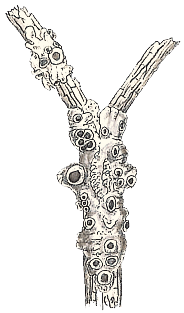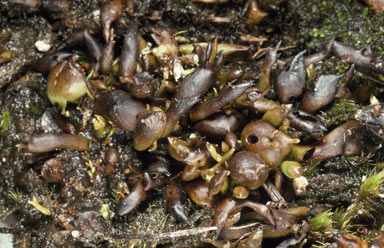|
Lichen biogeography - Lichens in Australia
Endemic to Australia
What is an endemic Australian species? Here it is defined as one currently known only from Australia and, for the purpose of this page, Australia is taken to be Tasmania and the mainland states and territories. Politically various more distant islands (such as Lord Howe, Macquarie and Norfolk) are part of Australia but botanically they are distinct from Tasmania and the mainland and for biogeographic purposes are therefore best treated as outside Australia. Some endemic species may have evolved in Australia after the break-up of Gondwana. Some may have moved to Australia from elsewhere and become extinct in their original homes. Others may have been very widespread in an area that included ancient Australia but have disappeared from all those other areas. Clearly there are various ways in which today's endemic species could have arisen but this page won't go into hypotheses for the various examples given below.
References I won't crowd this page with a specific reference for each distribution example. The information has come mostly from the relevant generic treatments of the lichen volumes in the Flora of Australia series. The occasional published sources of extra information will appear in additional reference buttons. In a very few cases I have included additional, unpublished distributional information gleaned from reliably identified Australian specimens in the Australian National Herbarium in Canberra. |
In January 2011 there were about 3600 lichen species recorded for Australia, of which about 1200 were endemic, and in future you should be able to find approximate, up to date total and endemic species counts here. The aim of the current page is simply to illustrate various distribution patterns with some examples, rather than to give an exhaustive account. Many of the non-endemic species found in Australia are also distributed in similar ways and you will find some examples on the XANTHOPARMELIA page. The examples given below will mostly be at the species level since there are few endemic genera and these will be dealt with first.
Endemic genera
The genera endemic to Australia are small, each containing just one or two species and they are confined to eastern Australia. This section will note where those species occur, with the mainland locations shown on an accompanying map. A number of the species are found in Tasmania but those locations are not mapped since it would be difficult to show them all distinctly on the map and for the present purpose such fine detail is not important.
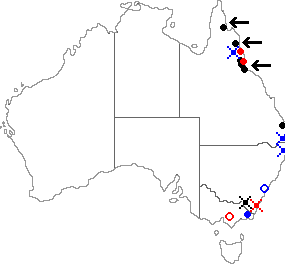 Amphorothecium occultum is the only species of the genus Amphorothecium and is known from only the type locality in south-eastern New South Wales, shown by the red cross on the map to the right. Whenever a new species is described the specimen on which the description is based is known as the type specimen for that species and the location in which the type specimen was collected is the type locality. In order to draw any sensible conclusions about a species' likely distribution it is desirable to have collections from a number of locations in order to build up a good picture of a species' preferences. It is impossible to draw any conclusions about the possible wider distribution for a species known from just the type location, since there is no way of knowing whether, at the type location, the species is behaving in a typical or atypical way. Hueidea and Ramalodium are two other genera, each containing just one species and known only from New South Wales. Hueidea australiensis is known from a couple of sites near Mt. Kosciuszko, both within the area marked by the black cross on the map and Ramalodium succulentum (blue circle) is known only from the type locality near Sydney. Tibellia's single species (Tibellia dimerelloides) has been found in northern and south-eastern Queensland and north-east New South Wales (blue crosses). The two species of Myelorrhiza are known only from Queensland (Myelorrhiza antrea - red dots and Myelorrhiza jenjiana - black dots). Another endemic Queensland genus is Squamella, its one species Squamella spumosa being known from several northern coastal sites indicated with black arrows on the map. The genus Jarmania contains just two species (Jarmania scoliciosporoides and Jarmania tristis) both of which are known from Tasmania and Victoria. In Victoria it's known from the Erinnundra area of Gippsland, indicated by the blue dot. The genus Tasmidella contains one species (Tasmidella variabilis) with two chemically distinct varieties, one of which is known only from Tasmania while the other is known to occur in both Tasmania and Victoria (in the area marked with a red circle, east of Melbourne). Meridianelia maccarthyana and Siphulella coralloidea (the sole species in their respective genera) are known only from Tasmania
Amphorothecium occultum is the only species of the genus Amphorothecium and is known from only the type locality in south-eastern New South Wales, shown by the red cross on the map to the right. Whenever a new species is described the specimen on which the description is based is known as the type specimen for that species and the location in which the type specimen was collected is the type locality. In order to draw any sensible conclusions about a species' likely distribution it is desirable to have collections from a number of locations in order to build up a good picture of a species' preferences. It is impossible to draw any conclusions about the possible wider distribution for a species known from just the type location, since there is no way of knowing whether, at the type location, the species is behaving in a typical or atypical way. Hueidea and Ramalodium are two other genera, each containing just one species and known only from New South Wales. Hueidea australiensis is known from a couple of sites near Mt. Kosciuszko, both within the area marked by the black cross on the map and Ramalodium succulentum (blue circle) is known only from the type locality near Sydney. Tibellia's single species (Tibellia dimerelloides) has been found in northern and south-eastern Queensland and north-east New South Wales (blue crosses). The two species of Myelorrhiza are known only from Queensland (Myelorrhiza antrea - red dots and Myelorrhiza jenjiana - black dots). Another endemic Queensland genus is Squamella, its one species Squamella spumosa being known from several northern coastal sites indicated with black arrows on the map. The genus Jarmania contains just two species (Jarmania scoliciosporoides and Jarmania tristis) both of which are known from Tasmania and Victoria. In Victoria it's known from the Erinnundra area of Gippsland, indicated by the blue dot. The genus Tasmidella contains one species (Tasmidella variabilis) with two chemically distinct varieties, one of which is known only from Tasmania while the other is known to occur in both Tasmania and Victoria (in the area marked with a red circle, east of Melbourne). Meridianelia maccarthyana and Siphulella coralloidea (the sole species in their respective genera) are known only from Tasmania![]() .
.
Species known from limited areas
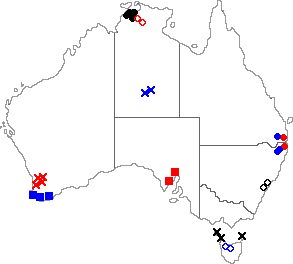 There are many endemic species that are known from limited areas and you have seen some examples in the previous section. There are many species which, though known from more than just the type locality, are still known from rather small areas and this section will give you some examples. For some species, such a limited distribution may be the reality but for others their seemingly limited distributions would be more a reflection of insufficient lichenological exploration, with future field work likely to show the species to be more widespread.
There are many endemic species that are known from limited areas and you have seen some examples in the previous section. There are many species which, though known from more than just the type locality, are still known from rather small areas and this section will give you some examples. For some species, such a limited distribution may be the reality but for others their seemingly limited distributions would be more a reflection of insufficient lichenological exploration, with future field work likely to show the species to be more widespread.
Cryptothecia exilis (black dots) and Pertusaria dissita (red circles) are known from the north-west of the Northern Territory while Peltula imbricata (blue crosses) is known from the southern half of the Northern Territory. Lecanora austrointumescens (blue squares) and Hypocenomyce isidiosa (red crosses) are known from the south-west of Western Australia. Bagliettoa operculata (red squares) is known from two areas in southern South Australia. Buellia subtropica (blue dots) and Pyrenula bicuspidata (red dots) are known from south-east Queensland and north-east New South Wales. Pertusaria complanata (black circles) is known from an area further south in New South Wales. Verrucaria tholocarpa (blue circles) can be found growing on aquatic limestone in northern Tasmania and Porina meridionalis (black crosses) is known only from several Bass Strait islands.
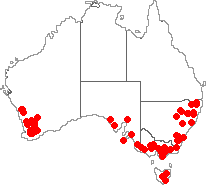 Each of the species mentioned in the previous paragraph is known from several locations and sometimes the limited information we already have about a species (and also information about other species in the genus) can be enough to suggest where else it could be found. For interest sake I will show what speculation is possible, using three of the species as examples. It would not be surprising to find Verrucaria tholocarpa on aquatic limestone in other areas of Tasmania, but though it might be found elsewhere in Tasmania it could well be confined to the state. Bass Strait is an effective obstacle to the movement of species between Tasmania and mainland Australia and the island state is well-known for various plant and animal species that are not found elsewhere in Australia. Some species endemic to Tasmania have already been mentioned in the previous section and there'll be a few more examples later on. Hypocenomyce isidiosa grows on charred wood (a common substrate for some other species in the genus) in sclerophyll woodlands. Within south-western Australia there are further areas of sclerophyll woodland, so searching charred wood in such areas could yield further specimens. Moreover, some species of Hypocenomyce are found in both the east and the west, which prompts the question of whether Hypocenomyce isidiosa will one day be found in eastern Australia. The map on the right shows the distribution of the genus in Australia and the species are found generally in forests. Hypocenomyce isidiosa is the only species of the genus that has been found in Western Australia but not in eastern Australia. If the species evolved in Western Australia after the drying of central Australia then dispersal to eastern Australia would be difficult - assuming it requires forests and charred wood, since there would be little in the way of suitable habitats in between. The question of species found in both eastern and western Australia (but not in between) is discussed further on.
Each of the species mentioned in the previous paragraph is known from several locations and sometimes the limited information we already have about a species (and also information about other species in the genus) can be enough to suggest where else it could be found. For interest sake I will show what speculation is possible, using three of the species as examples. It would not be surprising to find Verrucaria tholocarpa on aquatic limestone in other areas of Tasmania, but though it might be found elsewhere in Tasmania it could well be confined to the state. Bass Strait is an effective obstacle to the movement of species between Tasmania and mainland Australia and the island state is well-known for various plant and animal species that are not found elsewhere in Australia. Some species endemic to Tasmania have already been mentioned in the previous section and there'll be a few more examples later on. Hypocenomyce isidiosa grows on charred wood (a common substrate for some other species in the genus) in sclerophyll woodlands. Within south-western Australia there are further areas of sclerophyll woodland, so searching charred wood in such areas could yield further specimens. Moreover, some species of Hypocenomyce are found in both the east and the west, which prompts the question of whether Hypocenomyce isidiosa will one day be found in eastern Australia. The map on the right shows the distribution of the genus in Australia and the species are found generally in forests. Hypocenomyce isidiosa is the only species of the genus that has been found in Western Australia but not in eastern Australia. If the species evolved in Western Australia after the drying of central Australia then dispersal to eastern Australia would be difficult - assuming it requires forests and charred wood, since there would be little in the way of suitable habitats in between. The question of species found in both eastern and western Australia (but not in between) is discussed further on.
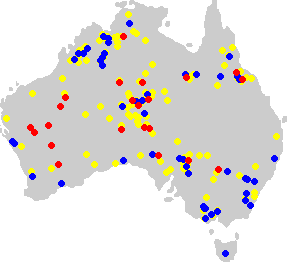 Species of Peltula are often found in the world's arid areas and within Australia various non-endemic species are widespread through the arid interior (and sometimes beyond). The blue, red and yellow dots on the map to the right show the distribution of the 15 species of Peltula known to be in Australia and two species have been singled out. The blue dots indicate the Australian distribution of the cosmopolitan species Peltula euploca, the red dots that of Peltula patellata, (known also from Mexico and North America, southern Europe, Africa, Cape Verde Islands and India) and the yellow dots the combined distributions of the remaining species. Peltula euploca grows mostly on acidic rocks and is very rare on calcareous rocks whereas Peltula patellata grows on calcareous substrates. This information about the genus Peltula shows that it would not be surprising to find Peltula imbricata through at least more of Australia's inland.
Species of Peltula are often found in the world's arid areas and within Australia various non-endemic species are widespread through the arid interior (and sometimes beyond). The blue, red and yellow dots on the map to the right show the distribution of the 15 species of Peltula known to be in Australia and two species have been singled out. The blue dots indicate the Australian distribution of the cosmopolitan species Peltula euploca, the red dots that of Peltula patellata, (known also from Mexico and North America, southern Europe, Africa, Cape Verde Islands and India) and the yellow dots the combined distributions of the remaining species. Peltula euploca grows mostly on acidic rocks and is very rare on calcareous rocks whereas Peltula patellata grows on calcareous substrates. This information about the genus Peltula shows that it would not be surprising to find Peltula imbricata through at least more of Australia's inland.
Along the Great Dividing Range (and perhaps a little more)
On mainland Australia the Great Dividing Range parallels the eastern coastline from Cape York Peninsula in the north through to central Victoria in the south. This largely north-south range and the relatively narrow coastal strip alongside are markedly different (in terms of vegetation and climate) to the areas on the inland side of the Great Dividing Range. There are numerous habitats and microhabitats in those areas and therefore it should be no surprise to learn that many species are found predominantly along the Divide (or the associated coastal strip) and perhaps also a little westward or south to Tasmania.
Amongst such species some are very widespread, being found along much or all of the north-south length, though sometimes with gaps in the known distribution and the following maps give four examples: Pertusaria clarkeana (leftmost), Phaeographis subintricata (second), Ramboldia plicatula (third) and Relicina limbata (rightmost).
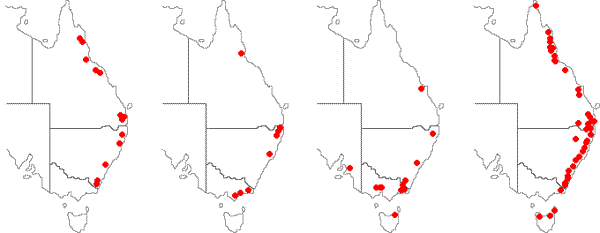
There is considerable variation in vegetation and climate along the Great Dividing Range and the accompanying coastal strip. In the north are tropical rainforests while in the south are cool temperate rainforests and along the range there are sclerophyll forests of various compositions. Hence, as well as widespread species such as those of the previous maps there are also species with more limited known distributions. The following maps show the known distributions of five species thus far found only near the northern half of the Great Dividing Range. The leftmost trio of small maps show some species thus far known only from the tropical areas: Haematomma stevensiae (red dots), Pertusaria xanthodactylina (blue dots) and Porina bacillifera (black dots). The remaining maps show more widespread species: Lecanora hypocrocinoides (first of the larger maps), Melanotrema endomelaenum (second), Polymeridium sulphurescens (third) and Xanthoparmelia subtropica (rightmost, and with a distribution extending a little further west than the others in this series).

The following maps show several species known predominantly from the southern areas: Fissurina elixii (leftmost map, red dots), Xanthoparmelia lithophiloides (leftmost map, blue dots), Fuscopannaria decipiens (second map), Canoparmelia corrugativa (third map, blue dots), Graphis centrifuga (third map, red dots), Pertusaria leucothelia (fourth map) and Topeliopsis decorticans (rightmost map).

The north
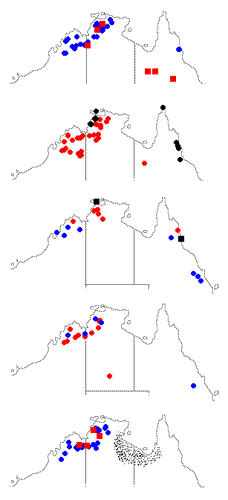 A large part of northern Australia lies in the tropics and offers a variety of habitats. Dense rainforests can be found along the northern part of the Great Dividing Range in the east. Further west are savannahs or savannah woodlands and monsoon forests. The southern inland parts of Australia's tropics are arid and arid country covers much of the continent's inland. In the north of the Northern Territory and Western Australia there is a variety of escarpments or convoluted ranges, some almost bare of soil, the exposed areas of which can experience very high temperatures, but also with sheltered areas that may see little sunlight during the day. Not surprisingly these macro-habitats provide a great variety or microhabitats with niches for many lichen species. A little earlier you saw some examples of species known only from the tropical parts of the Great Dividing Range and its associated coastal strip. The maps to the right show some tropical species found to the west of the Great Dividing Range. The topmost map shows the known distributions of Dimelaena elevata (blue dots) and Dirinaria minuta (red squares) and the map immediately below those of Graphis vinosa (black dots) and Lecanora austrosorediosa (red dots). The third: Buellia vioxanthina (red dots), Pyrenula xanthominuta (black squares) and Pyxine rugulosa (blue dots). The fourth: Buellia kimberleyana (red dots) and Pyxine desudans (blue dots). The final map features Tephromela arafurensis (blue dots) and Tephromela stenosporonica (red squares). Though these maps show the details of only a few species one immediately obvious feature is the paucity of markings in the Gulf Country, namely the land bordering the southern half of the Gulf of Carpentaria and marked as a speckled area in the final map. This page deals with endemic species but even if you looked at the Australian distributions of non-endemic lichens you'd still find a paucity of records from the Gulf Country. Surely there must be a good variety of lichens in the Gulf Country but the area is still largely unexplored when it comes to lichens
A large part of northern Australia lies in the tropics and offers a variety of habitats. Dense rainforests can be found along the northern part of the Great Dividing Range in the east. Further west are savannahs or savannah woodlands and monsoon forests. The southern inland parts of Australia's tropics are arid and arid country covers much of the continent's inland. In the north of the Northern Territory and Western Australia there is a variety of escarpments or convoluted ranges, some almost bare of soil, the exposed areas of which can experience very high temperatures, but also with sheltered areas that may see little sunlight during the day. Not surprisingly these macro-habitats provide a great variety or microhabitats with niches for many lichen species. A little earlier you saw some examples of species known only from the tropical parts of the Great Dividing Range and its associated coastal strip. The maps to the right show some tropical species found to the west of the Great Dividing Range. The topmost map shows the known distributions of Dimelaena elevata (blue dots) and Dirinaria minuta (red squares) and the map immediately below those of Graphis vinosa (black dots) and Lecanora austrosorediosa (red dots). The third: Buellia vioxanthina (red dots), Pyrenula xanthominuta (black squares) and Pyxine rugulosa (blue dots). The fourth: Buellia kimberleyana (red dots) and Pyxine desudans (blue dots). The final map features Tephromela arafurensis (blue dots) and Tephromela stenosporonica (red squares). Though these maps show the details of only a few species one immediately obvious feature is the paucity of markings in the Gulf Country, namely the land bordering the southern half of the Gulf of Carpentaria and marked as a speckled area in the final map. This page deals with endemic species but even if you looked at the Australian distributions of non-endemic lichens you'd still find a paucity of records from the Gulf Country. Surely there must be a good variety of lichens in the Gulf Country but the area is still largely unexplored when it comes to lichens![]() .
.
Through the arid lands
Many parts of Australia are arid, particularly much of the country more than 200 kilometres inland, but the arid country reaches the sea to the south for a considerable stretch either side of the Western and South Australian border. There is also arid coastal country along a large part of the Indian Ocean coastline of Western Australia. Many lichens are found in these areas and amongst them are a number of endemic species, some of which seem to be confined to the arid areas while others are more widely distributed. The following two maps give examples of endemic Australian species that are widespread through Australia's arid country but which are also found in the non-arid areas to the south-west or east of the country. On the left are the details for Endocarpon helmsianum (red dots) and Heterodea beaugleholei (blue dots) and on the right those for Paraporpidia glauca (red dots) and Flavoparmelia ferax (blue dots). The southernmost map point for the last species indicates a specimen collected from Curtis Island in Bass Strait. You'll notice that Heterodea beaugleholei shows an almost continuous distribution from the west coast to the east coast across the southern half of Australia, with Paraporpidia glauca and Flavoparmelia ferax not that far behind in the east-west coverage of the continent.
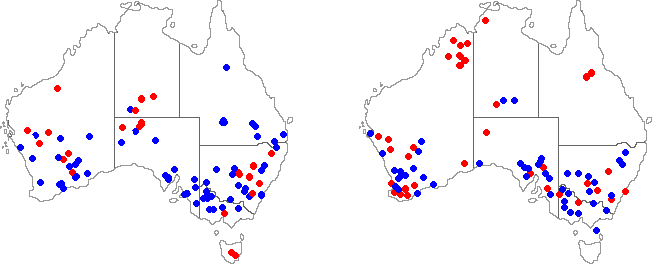
As well as very widespread species, such as the four that featured in the previous two maps, there are other species which, though they may be found over fairly wide areas, are thus far known from more limited areas. The next two maps give some examples. The left hand map shows the details for Buellia dijiana (red dots), Buellia lobata (blue dots) and Flavoparmelia scabrosina (black squares) and the map on the right those for Diploschistes elixii (red circles), Endocarpon rogersii (red dots), Xanthoparmelia ballingalliana (blue dots) and Xanthoparmelia saginata (black dots). The genus Xanthoparmelia is widespread and common in the drier areas and there's more information, including additional biogeographic comments, on the XANTHOPARMELIA page. The black speckled area in Western Australia's south-west indicates the known distribution of Haematomma eremaeum ![]() and there are many herbarium collections of this species from there. You'll notice three very obvious outliers in these maps: eastern New South Wales for Buellia dijiana, south-west Western Australia for Flavoparmelia scabrosina and the same state's west for Xanthoparmelia saginata. Maps such as these are always thought-provoking for they suggest (though of course don't prove) that the various species may be found also in the areas between their respective outlying and more concentrated points
and there are many herbarium collections of this species from there. You'll notice three very obvious outliers in these maps: eastern New South Wales for Buellia dijiana, south-west Western Australia for Flavoparmelia scabrosina and the same state's west for Xanthoparmelia saginata. Maps such as these are always thought-provoking for they suggest (though of course don't prove) that the various species may be found also in the areas between their respective outlying and more concentrated points![]() .
.
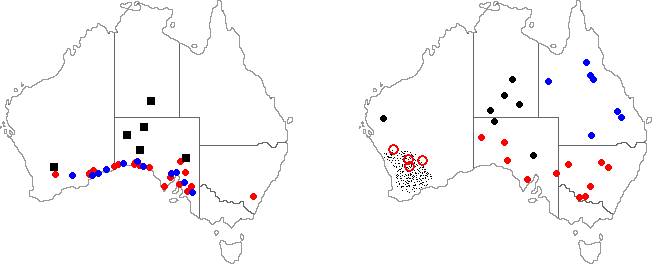
Southern east-west disjunct species
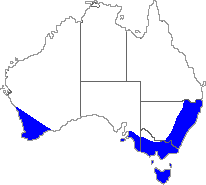 In the previous section you saw examples of species that are found in the east and the west of Australia as well as in many intermediate areas. There are also endemic species that have been found in the south-west of Western Australia as well as in the eastern states (particularly the south-east of the country) but not in between. The terms south-west and south-east are not precisely defined in any botanical, climatic or geological sense but I mean roughly the areas marked in blue on the map to the right. The south-west and much of the south-east have a temperate climate, are well-watered when compared to most of the southern half of Australia and offer a variety of broadly similar habitats that are absent from the area in between. It is therefore not too surprising that various lichens are able to exist in each of those widely separated areas. As stated a few times on this website there is much of Australia still to be explored from a lichenological aspect and it is always possible that some of the species thus far found only in the south-west and south-east will one day be found at various places in between. On the other hand there has been a reasonable degree of lichenological investigation of various dry areas in the southern parts of Western and South Australia. Furthermore various east-west disjuncts have never been found in habitats resembling any of those found in the intermediate areas. It is certainly true that amongst the east-west disjuncts are cryptic species that could be overlooked in the field but there are also many that are easily noticeable. Given these facts it is reasonable to suppose that at least a large proportion of these east-west disjunct species could not survive in the intervening harsh country and that they are in fact absent from that intervening area. In some cases it may be that a species has evolved on one side of the continent but then dispersed to the other side. It is also possible that some species were once much more widespread. Millions of years ago there were forests in the intervening area and it would have been capable of supporting lichens of forested or well-watered habitats. Over time, as that country became drier and drier, such lichens would have disappeared from the central areas. Any lichen species that had been found throughout southern Australia could well have continued to survive in both the south-west and the east of Australia and so given rise to some of today's east-west disjunct species.
In the previous section you saw examples of species that are found in the east and the west of Australia as well as in many intermediate areas. There are also endemic species that have been found in the south-west of Western Australia as well as in the eastern states (particularly the south-east of the country) but not in between. The terms south-west and south-east are not precisely defined in any botanical, climatic or geological sense but I mean roughly the areas marked in blue on the map to the right. The south-west and much of the south-east have a temperate climate, are well-watered when compared to most of the southern half of Australia and offer a variety of broadly similar habitats that are absent from the area in between. It is therefore not too surprising that various lichens are able to exist in each of those widely separated areas. As stated a few times on this website there is much of Australia still to be explored from a lichenological aspect and it is always possible that some of the species thus far found only in the south-west and south-east will one day be found at various places in between. On the other hand there has been a reasonable degree of lichenological investigation of various dry areas in the southern parts of Western and South Australia. Furthermore various east-west disjuncts have never been found in habitats resembling any of those found in the intermediate areas. It is certainly true that amongst the east-west disjuncts are cryptic species that could be overlooked in the field but there are also many that are easily noticeable. Given these facts it is reasonable to suppose that at least a large proportion of these east-west disjunct species could not survive in the intervening harsh country and that they are in fact absent from that intervening area. In some cases it may be that a species has evolved on one side of the continent but then dispersed to the other side. It is also possible that some species were once much more widespread. Millions of years ago there were forests in the intervening area and it would have been capable of supporting lichens of forested or well-watered habitats. Over time, as that country became drier and drier, such lichens would have disappeared from the central areas. Any lichen species that had been found throughout southern Australia could well have continued to survive in both the south-west and the east of Australia and so given rise to some of today's east-west disjunct species.
The next two maps give some examples of species found in the south-west and the south-east.
The map on the left gives the details for Buellia metaphragmia (red dots) and Buellia microsporella (blue dots) while the map on the right features Menegazzia platytrema ![]() (blue dots) and Ramboldia blastidiata (red dots).
(blue dots) and Ramboldia blastidiata (red dots).
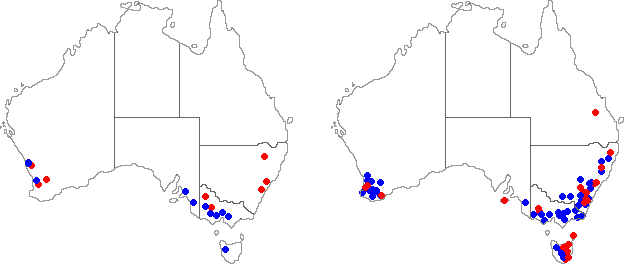
Of the following two maps that on the left gives the details for Canoparmelia norsticticata (black squares), Lepraria dibenzofuranica (blue dots) and Menegazzia fertilis (red dots) while the map on the right features Fuscidea ramboldioides (red dots), Hypocenomyce tinderryensis (black squares) and Porina hyperleptalea (blue dots). The blue dot in Bass Strait represents a specimen collected from Curtis Island.

'Islands'
An island is a piece of land separated by water from other land. If the separation is large enough then neither organisms nor propagules can travel to or from the island, or at least the chances of such travel are small. If the separation has existed for a sufficiently long time then it is likely that species unique to the island will have evolved. If you want to find out more about islands and their species in general all you need do is search for the subject "island biogeography".
Tasmania , though once joined to mainland Australia, has long been separated by Bass Strait and consists of one large island and several smaller islands within the strait. Tasmania has a wide variety of habitats and many endemic lichen species, some of which have already been mentioned above, namely Meridianelia maccarthyana and Siphulella coralloidea (the sole species in their respective genera), Porina meridionalis (known only from several Bass Strait islands) and Verrucaria tholocarpa (found growing on aquatic limestone in northern Tasmania). Three more examples are Chapsa asteliae, Cladia moniliformis and Fellhanera tasmanica, A large proportion of the species endemic to Tasmania are each known from few locations and an extreme example of this is Fellhanera tasmanica. A description of this species was first published in 2001 and was based on material collected on fern leaves in 1979 and to date it is known only from the type locality. Species known only from their type localities were mentioned in passing earlier on this page, with the comment that it is impossible to make any good conjectures as to where else such species might be found. By contrast Chapsa asteliae is known from a number of sites but always on dead leaves of Astelia alpina in subalpine or alpine heathland in western Tasmania and at some sites the species is fairly common. It is worth noting that the host plant is also found in the alpine country of eastern Victoria and southern New South Wales. These facts prompt speculation as to whether Chapsa asteliae is confined to the one host and whether it might be found on mainland Astelia. Cladia moniliformis is found at many sites in the wetter, western half of Tasmania, from sea level to alpine altitudes. Of the three it is the most widespread, but is seemingly intolerant of the drier parts of the state![]() .
.
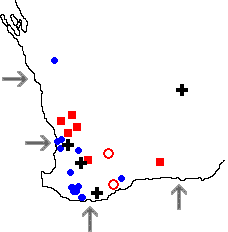 Some regions, though not islands, can be treated as such. A good example of this is the south-west of Western Australia, which has already featured in the early section about east-west disjunct species. Half of the south-west is bordered by ocean and the other half by arid Australia. For species dependent on the benign conditions of the south-west arid Australia is as effective as an ocean in isolating the south-west from similar habitats to the east. Certainly, as you've seen above, there are species found in both the east and west of Australia (just as there are species common to Tasmania and the Australian mainland). However, given the long isolation of the south-west from the east it's not surprising that the former area has endemic species. The earlier section about east-west disjunct species noted that millions of years ago there were forests in parts of now-arid Australia and such areas would have been capable of supporting lichens of more benign habitats. Over time, as those areas dried out, such lichens would have disappeared or for some their distributions may have contracted westward, giving rise to some of today's endemic species of south-west Australia. On the other hand central Australia has been dry for such a long time that there has been ample time for the evolution of south-west endemics after the drying. You've already seen two examples of south-western endemics mentioned earlier: Haematomma eremaeum (also found in the nearby arid area), Hypocenomyce isidiosa and Lecanora austrointumescens. The map on the right charts some more examples: Endocarpon macrosporum (black crosses), Flavoparmelia marchantii (blue dots), Flavoparmelia proeuplecta (red squares) and Xanthoparmelia scabrosina (red circles). The grey arrows indicate the positions of several coastal towns or cities: Geraldton (northernmost), then Perth, Albany and Esperence in that order.
Some regions, though not islands, can be treated as such. A good example of this is the south-west of Western Australia, which has already featured in the early section about east-west disjunct species. Half of the south-west is bordered by ocean and the other half by arid Australia. For species dependent on the benign conditions of the south-west arid Australia is as effective as an ocean in isolating the south-west from similar habitats to the east. Certainly, as you've seen above, there are species found in both the east and west of Australia (just as there are species common to Tasmania and the Australian mainland). However, given the long isolation of the south-west from the east it's not surprising that the former area has endemic species. The earlier section about east-west disjunct species noted that millions of years ago there were forests in parts of now-arid Australia and such areas would have been capable of supporting lichens of more benign habitats. Over time, as those areas dried out, such lichens would have disappeared or for some their distributions may have contracted westward, giving rise to some of today's endemic species of south-west Australia. On the other hand central Australia has been dry for such a long time that there has been ample time for the evolution of south-west endemics after the drying. You've already seen two examples of south-western endemics mentioned earlier: Haematomma eremaeum (also found in the nearby arid area), Hypocenomyce isidiosa and Lecanora austrointumescens. The map on the right charts some more examples: Endocarpon macrosporum (black crosses), Flavoparmelia marchantii (blue dots), Flavoparmelia proeuplecta (red squares) and Xanthoparmelia scabrosina (red circles). The grey arrows indicate the positions of several coastal towns or cities: Geraldton (northernmost), then Perth, Albany and Esperence in that order.
Within Australia there are other 'islands', such as the Kimberley area and the nearby parts of the Northern Territory. You've seen a couple of examples of species known just from there. Within the arid parts of Australia there are various gorges, sometimes with permanent water and so veritable oases within an otherwise harsh landscape. There are some lichen species known only from type localities in such small 'islands'.
Puzzles
You have of course already come across various puzzles on this web page. Every species that is thus far known from only the type locality or from a very limited area is automatically a puzzle. Such limited known distributions immediately prompt the question: Do the species occur elsewhere? For a species with a disjunctive distribution it's natural to wonder immediately: Does it occur in between? The discussion of the southern east-west disjunct species showed that there is a very plausible explanation for some disjunct species. But what of species such as Canoparmelia corrugativa and Lecanora hypocrocinoides. These featured earlier but the left hand map of the pair below repeats the details (blue dots for Canoparmelia corrugativa and red for Lecanora hypocrocinoides). Given their substrates and known habitats there it seems reasonable to suppose that each species occurs in the intervening areas. The map on the right gives some more examples of puzzling distributions: Diploschistes microsporus (black squares), Lepraria squamatica (red dots) and Letrouitia leprolytoides (blue dots).
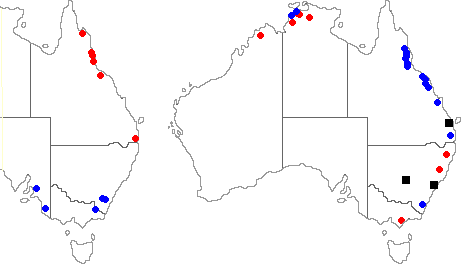
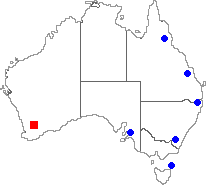 We'll finish the page by observing that sometimes a species goes from being one type of puzzle to being a different type of puzzle. The final map gives the known distribution of Ramboldia crassithallina, the first published description of which appeared in 2001 and was based on specimens collected in Western Australia. The genus Ramboldia was dealt with in volume 56A of the Flora of Australia, which appeared in 2004 and at the time the species was still regarded as endemic to Western Australia and was known only from a couple of sites within the area marked by the red square. An updated discussion of the genus was published in 2009 (Volume 57 of the Flora of Australia) and by then the species was also known from the places indicated by blue dots. The currently known distribution of the species still prompts the question of: Where else?
We'll finish the page by observing that sometimes a species goes from being one type of puzzle to being a different type of puzzle. The final map gives the known distribution of Ramboldia crassithallina, the first published description of which appeared in 2001 and was based on specimens collected in Western Australia. The genus Ramboldia was dealt with in volume 56A of the Flora of Australia, which appeared in 2004 and at the time the species was still regarded as endemic to Western Australia and was known only from a couple of sites within the area marked by the red square. An updated discussion of the genus was published in 2009 (Volume 57 of the Flora of Australia) and by then the species was also known from the places indicated by blue dots. The currently known distribution of the species still prompts the question of: Where else?
Lichen biogeography pages on this website Distribution patterns |
![An Australian Government Initiative [logo]](/images/austgovt_brown_90px.gif)


